White Lightning

I had a query about what the hell it is that Chuck Miller distills at Belmont Farms.
Simple, really. Moonshine- White Lightning- is fresh whiskey made from a combination of corn, barley, rye or wheat. The grains are ground up and mixed with water, then cooked, mixed with yeast and malt and left to ferment. The resultant Mash is then boiled in a still. The mash vaporizes and the gas rises up into a condenser where it cools and condenses into liquid.
The product is clear, and bottled straight away without aging for the simple fact that it is usually being produced without benefit of permission of the state. You can get a delicate caramel color if you age the whiskey in casks, and Chuck is not above (or below) that.
It is a perfectly straightforward process, but there are two operations at Belmont Farms, one new and one old enough to pre-date the nation. The front end of it is the system of systems managed by farmer Miller, owner of Belmont Farms. His motto about his moonshine production is “Single estate, Grain to Glass,” and his Kopper Kettle line of fine raw whiskey and vodka.
It is an interesting story that we only scratched at yesterday. Chuck and his wife Jeanette bought the 140-acre property down the road from Refuge Farm in the 1970s with the intent of raising horses and cattle and the hay and corn to feed them. Chuck’s day job as a commercial pilot gave him the opportunity to run the farm as a side business.
This was back in the 1970s, when the wine industry was exploding in this region. Chuck saw the trend and decided to expand into grape production, but quickly discovered that it required too much labor to baby the vines and do the picking.
Casting about for another approach, he recalled that his grandfather had operated a still in the days of the Volstead Act, and had supplied the Imperial City with potable alcohol, conveniently delivered at night, to avoid the laws that they had passed and imposed on the rest of the country.
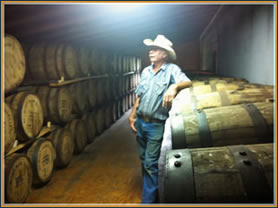
(Chuck Miller in his barrel room at Belmont Farms. Photo Chuck Miller).
Chuck didn’t have the recipe for making moonshine, but one of the older members of the family did. Great-Uncle Johnny had it, along with tall tales of the wild business of evading the Revenuers on the way to Washington and sometimes a bit of gun-play.
As a licensed pilot, Chuck is an upstanding citizen, and he set about the laborious process of obtaining the necessary permits from Richmond to do his whiskey distilling legally. It took two years, but the folks at the Bureau of Alcohol, Tobacco and Firearms in DC and the Virginia Department of Alcoholic Beverage Control in Richmond eventually said it was OK.
He found his copper still on a farm down near Charlottesville, and went into business.
Therein lies the path to the other two stories, the one stacked on the other. The distilling business has a long history on this continent, older that the Republic by far. It is easier to make whiskey than it is to make wine or brew beer. The drink of choice for Colonial America was whiskey, raw and wild.
You can even say that corn whiskey is the reason for the way our government was chartered. The Revolution established a nation independent of the Crown. It did not establish a Constitution. Instead, the Articles of Confederation governed the new relationship between the former colonies, and the nascent Continental government, and therein lay the roots of the Whiskey Insurrection, also known as Shay’s Rebellion.
It is worth a book all in itself. A revolutionary war solider named Daniel Shay- mustered out of the Continental Army without pay, returning home to find himself in deep tax trouble- often gets the credit for the revolt against Alexander Hamilton’s taxes. It is a much more nuanced story to which I don’t have time to do justice this morning.
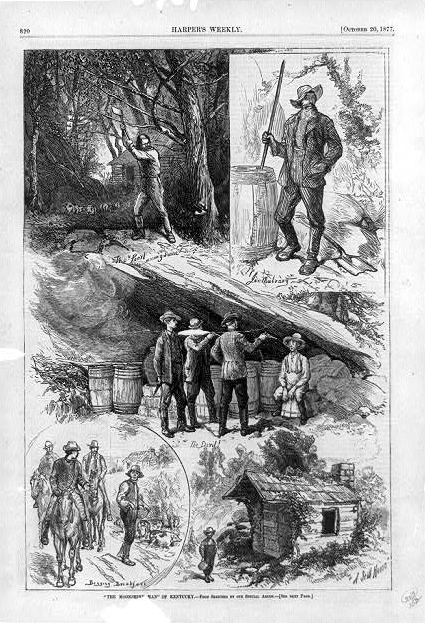
(Harper’s Weekly steel engraving of frontier moonshining, circa 1870. Image harpers).
The short answer is almost always wrong, but here goes: the brief insurrection is often depicted as being conducted by poor, Western Massachusetts farmers embittered by land seizures and bankruptcies. It was actually much more widespread than the Keystone Colony, and the taxation-without-representation thing many of the ex-soldiers had fought the Red Coats about was very much part of it. Some research into the lives of Shays Rebels suggests that Whiskey Rebels they came from “diverse socio-economic backgrounds (from the wealthiest to the poorest families in the nation), professions, and locales” and that their issues included: rule by a faraway elite, cronyism and corruption at influential levels of government, and regressive tax policy.
Stop me if you have heard this before.
Thomas Jefferson, then Ambassador to Paris, observed to a friend that a little rebellion was not a bad thing in his view, quipping: “The tree of liberty must be refreshed from time to time with the blood of patriots and tyrants. It is its natural manure.”
Mr. Jefferson was an earthy fellow, and the quote has become sanitized over time, and more noble and less farm-like.
Anyway, Chuck at Belmont Farms has been legally producing whiskey- and paying his taxes- for a long time when he was approached by a bad boy named Tim Smith:

Tim is the Volunteer Fire Chief of Climax, VA, a little hamlet north of Danville near the North Carolina Border. Tim is a DESERT STORM vet, and married to a godly woman who is a school nutritionist and upstanding member of her church. Tim is also a third generation moonshiner.
I would have had to spend more time on the economics of traditional moonshining to demonstrate how embedded the custom is out in the country. Moonshine is easier to transport than grain, can be used as an alternate currency, and can be created, just at Chuck Miller does, all on one piece of property, grain to glass.
The other several Americas are still out there, though often nestled in the Hollers and on the bayous. The Discovery Channel has made some pretty good money out of making country people like the Robertsons of Duck Dynasty popular heroes- or horrors.

I think the Discovery Channel was interested in ridiculing them as a sort of modern day Green Acres caricature, but the vibrancy and authenticity of the family got away from them. The Robertsons and their Duck Commander still live in a world that connected to nature, and to values largely abandoned in ridicule by mainstream society. They evoke an America that seems largely mythical- or demonical- to the effete post-Baby Boomers who look a lot like Pajama Boy.
Tim Smith is riding that wave in his television show, along with his bib overalls with no shirt. His Climax Whiskey brand is a part of a total marketing package. It is authentic beyond doubt and evokes the memories of rebels from all the generations since Daniel Shay, sneering at the Federal Agents on a thousand versions of Rocky Top, driving their hot-rods at break-neck speed down the mountain to deliver white lightning to the flat-landers.
Anyway, Tim’s operations have expanded to legal distilleries in Virginia (like Belmont Farms) and Kentucky. You can check his television show, which purports to document the real life adventures of outlaw moonshiners, even as Tim goes legit through the good offices of people who actually comply with the myriad of alcohol regulations. I assume there is a product placement deal for Oshkosh bib overalls in there somewhere.
They did a lot of filming for the new fourth season of Moonshiners (Tuesdays, Discovery Channel, starting in October) so I will be tuning in to check out the neighborhood.
I was going to address Chuck Miller’s antique distilling process with his copper-pot still versus the towering modern and highly efficient column stills that allow continuous flow of mash over steam-generating plates that never need to be stopped or emptied, but clearly there is no time for that today.
I do have a large jug of Climate Moonshine and a stout clear bottle of Chuck’s Kopper Kettle white lightning. I will compare and contrast in a future review.
I think it is too soon to start drinking this morning. Of course, I am in the country, and you know different rules apply out here.
Copyright 2014 Vic Socotra
www.vicsocotra.com
Twitter: @jayare303
The Distillery
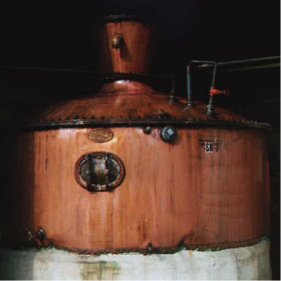
On Belmont Farm they grow their own corn, then they harvest the crop at this time of year, and store it in their two silos. When ready to handle it, they grind the corn and then they distill it into whiskey.
You can’t miss it, and I was kicking myself about not going sooner. I had got the impression somehow that the place was either for sale, or in transition from one thing to another and had not made it a priority to go there. I was still new to Culpeper back then, and the bright lights always dragged me over to the big box end of town.
These days, if I need something I drive south, away from the town, and patronize the little places along Rt 522 if I can.
Belmont Farms is very much there, and very much in operation about a mile off the big road, with a clearly marked sign:

The farmstead is about a mile up the gravel road. According to my cursory research, Belmont was an old English Land Grant ceded in 1836. During the Civil War, it was occupied by Union troops, and was a staging point for the fight at Cedar Mountain, where nearly 3,000 men perished in one day.
Upon the North’s departure, the main house was burned to the ground. During the great Depression a tenant house was built on the property that lasted until 1975, when it was replaced with the present brick Colonial home that sits in front of the industrial complex of the distillery.
There were convertible BMWs in a neat line out front, and dogs on the porch, and a former Deputy Director of Naval Intelligence in the check-out line with a bottle of moonshine. General chaos ensured as we talked about what the hell our two parties were doing there, and why, and we tasted six different products distilled inside.
According to the nice young woman who was pouring the white lighting, they add only choice malt to the corn meal, which is cooked in a large stainless steel cooker for about a day.
We saw it all in person when Maggie, a new transplant from NoVA who lives across the creek, took us inside. The yeast preparation is done in a stainless steel yeast tank, which is carefully stirred and watched attentively, according to Maggie, who was initially peeved that we had arrived in time for the last tour of the day.
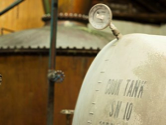
“Our copper pot still is truly the secret of our whiskey,” she said, clearly wanting us to be through the plant and on our way so she could close up for the weekend. “We follow a unique family recipe to cook the corn mash,” she said, pointing a bewildering assortment of tanks and holding containers. “After cooking is completed, the mash is sent to copper fermentation tanks for four days. The fermented mash is then sent to our 2000 gallon copper pot still and is distilled.”
I was curious- the copper pot still was constructed in 1930, which to the best of my recollection was during Prohibition. Apparently the good people at Belmont were in the business preparing for the passage of the 21st Amendment to the Constitution in 1933. A real piece of populist history. I saw a little sign that advertising for “night delivery drivers,” so the tradition continues.
Pot still production has been largely abandoned in the United States, but Belmont Farm continues the old tradition of the hills. “We have dedicated ourselves to the continuation of pot still whiskey,” Maggie said gesturing at the gigantic copper artifact. “Once the whiskey leaves the pot still, it then proceeds to the doubler, where it is further distilled, to increase the proof and insure our quality product.”
She urged us toward a passage into the bottling room, filled with equipment that would have been featured on the “Industry on Parade” newsreels they showed early in the morning when we were kids. “The whiskey is bottled here and labeled and prepared for shipment. Our operation at Belmont Farm Distillery is family owned and operated. We make copper pot still fresh whiskey in both our Virginia Lightning Corn Whiskey and our Kopper Kettle Virginia Whiskey.”

She ushered us down the long corridor lines with casks of whiskey, and eventually into the gift shop, where we stocked up on moonshine, whiskey and vodka. And T-shirts, of course. You can’t visit Belmont Farms without getting the t-shirts.
This is a must visit destination in Culpeper, and like I said, I should have come a long time ago. And I am going to be back, BTW. Next weekend they are featured in the Harvest Festival and will have two bluegrass bands and food.
And they will have whiskey. Real whiskey.
They are doing moonshine, too, but that is going to require another story.
Copyright 2014 Vic Socotra
www.vicsocotra.com
Twitter: @jayare303
Pickle-Brined Fried Chicken
“Vic,
W and I made the below on Tuesday. It was most excellent.
-Marlow”

(Part of the crowd at Willow, for Buffalo Night. Photo Socotra).
We are going to up the ante this morning and provide a cooking challenge with several moving part. I am going to do that partly because I don’t have time to solve the problems in the Middle East, and have to get down to the farm and see what the critters have got up to. I had a choice- I could have embarked on an account of Buffalo Night at Willow, but really, we have been down that road before. There was an all-star line-up at the bar, much joviality and laughter, and that is going to be one of the things I am going to miss the most about living in this strange triangular County lodged in the shadow of the Imperial City.
One of the other things that are on my DC bucket list is a trip to the wildly popular restaurant on Barrack’s Row, Rose’s Luxury. I am going to visit if my Baja California pal ever gets here. Bon Appetite magazine dubbed Rose’s the “best new restaurant in America,” and our correspondent and test-kitchen chef Marlow attempted to recreate one of the signature dishes:
Brined, boneless fried chicken thighs that produce incredible dark-meat flavor, and the dredge technique that creates an insanely crunchy coating.
You can find it in the Bon Appetite issue published in September, 2014.
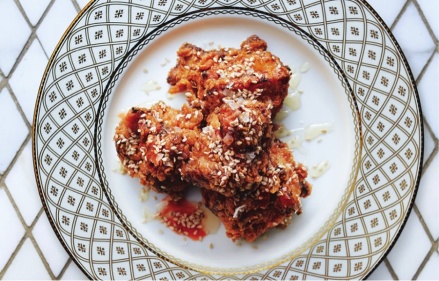
Servings: 4
INGREDIENTS
Brine
1 tablespoon yellow mustard seeds
1 tablespoon brown mustard seeds
1 ½ teaspoon coriander seeds
1 cup apple cider vinegar
⅔ cup kosher salt
⅓ cup sugar
¼ cup chopped fresh dill
Chicken
8 skinless, boneless chicken thighs (about 3 lb.), halved, quartered if large
Vegetable oil (for frying; about 10 cups)
2 cups buttermilk
2 cups all-purpose flour
Kosher salt
Honey, flaky sea salt (such as Maldon), toasted benne or sesame seeds, hot sauce (for serving)
Special equipment:
A deep-fry thermometer
Nutritional Information
Calories (kcal) 910 Fat (g) 41 Saturated Fat (g) 9 Cholesterol (mg) 335 Carbohydrates (g) 56 Dietary Fiber (g) 2 Total Sugars (g) 8 Protein (g) 76 Sodium (mg) 1690
PREPARATION
Brine
Toast mustard and coriander seeds in a dry medium saucepan over medium heat, tossing often, until mustard seeds begin to pop, about 3 minutes. Add vinegar, salt, and sugar and bring to a boil. Reduce heat and simmer, stirring often, until salt and sugar are dissolved, about 4 minutes. Remove from heat; stir in dill and 4 cups water. Let cool.
Chicken
Place chicken and brine in a large re-sealable plastic bag; chill 3 hours. Remove chicken from brine, scraping off seeds, cover, and chill until ready to fry.
Fit a large pot with thermometer and pour in oil to measure 2”. Heat over medium-high heat until thermometer registers 350°.
Meanwhile, place buttermilk in a large bowl. Place flour in another large bowl; season with kosher salt.
Working in batches, coat chicken in buttermilk, then dredge in flour, dipping your fingers in buttermilk as you pack flour on to help create moistened, shaggy bits (the makings of a super-crisp crust); transfer to a baking sheet.
Working in batches and returning oil to 350° between batches, fry chicken, turning occasionally, until skin is deep golden brown and crisp and chicken is cooked through, 6–8 minutes. Transfer to a wire rack set inside a baking sheet.
Drizzle chicken with honey; sprinkle with sea salt and benne seeds. Serve with hot sauce alongside.
Bon appetite!
Copyright 2014 Bon Appetite Magazine and Vic Socotra
www.vicsocotra.com
Twitter: @jayare303
News You Can Use

(Amru al-Absi, a non-moderate member of the Syrian opposition).
Here is some news you can use, as opposed to the usual recipe and hysteria update. I offer this in the context of Secretary Kerry’s remarks about combating the cheerful fellows who have established what they call the Islamic Caliphate in the lands that used to be Syria and Iraq:
“Let’s start by explaining what this fight is not. It is not a clash of civilizations….”
That was news right there. I confess to have been confused on that point, and appreciate the clarification. The Secretary went on to demonstrate his grasp of Islamic theology, saying that “Muslim scholars are outraged about the Islamic State’s brutality and perversion of Islam, calling its savagery deviant and heretical. Sunni and Shiite alike have joined forces against this outrage.”
Meanwhile, his staff at Main State was busy while Mr. Kerry was explaining what this isn’t. I was leafing through the Media Note I got from the Spokesperson at Foggy Bottom here in Washington. It is part of the effort to counter the threats posed by foreign terrorist fighters, I think, and State has newly designated ten individuals and two groups as Specially Designated Global Terrorists (SDGT) under Executive Order (E.O.) 13224, which imposes sanctions and penalties on terrorists and those providing support to terrorists or acts of terrorism.
There is a more comprehensive list some place- I fell asleep over my copy of the EO last night poking around looking for the one with IS, Boko Haram al-Qa`ida, Jabhat al-Nusra, and theTaliban. I had hoped to find reference to the non-terrorist but feircely fundamentalist sects of Wahhabis, Deobandis and Salafis–all of whom view the world through a simplistic but legitimately Islamic lens of Dar al-Islam versus Dar al-harb: or, the “house of Islam” and the “house of war.”
We reside in the latter, as you know.
I could only find the logos for the two groups- and looking for reliably-sourced pictures of the individuals led down too many rabbit holes and if I mis-identified someone and you saw them- say on the New York or London subways- it might lead to something unfortunate. So I will set that aside for the moment and allow our Department of Homeland Security to deal with them in their usual efficient manner.
You will note in the list there is no mention of the Khorasan Group, which was an imminent threat to the Homeland, according to Secretary Kerry and worthy of a couple dozen Tomahawk missiles fired from Navy ships in the Red Sea and Northern Arabian Gulf. Well done, Arliegh Burke and Philippine Sea!
As a result of the designations, all property subject to U.S. jurisdiction in which these individuals or groups have any interest is blocked and U.S. persons are generally prohibited from engaging in any transactions with them or to their benefit. I can’t imagine that you would, but it is useful to have a quick reference list handy.

Formed in February 2013, Jaish al-Muhajireen wal-Ansar (JAMWA) is a Chechen-led terrorist organization based in Syria that consists primarily of foreign fighters. Cooperating with other violent extremist organizations in Syria, including al-Nusrah Front and the Islamic State of Iraq and the Levant (ISIL), JAMWA has launched deadly assaults against civilian communities, and kidnapped civilians and other foreigners in Syria.

Formed in August 2013, Harakat Sham al-Islam (HSI) is a Moroccan-led terrorist organization operating in Syria principally composed of foreign fighters with a cool logo. HSI has carried out terrorist attacks and engaged in kidnappings against civilians with other violent extremist organizations in Syria, including al-Nusrah Front.
Moving to the individual threats, State gives us Amru al-Absi, who may be the fellow in the picture at the top of this story. He was selected as ISIL’s provincial leader for Homs, Syria, in the Aleppo region in July of this year. As a principal leader of ISIL in Syria, he has been in charge of the kidnapping, ransom and grisly beheading department.
Salim Benghalem is a Syria-based French extremist and ISIL member, who carries out executions on behalf of the group. In 2007, Salim was convicted and sentenced to prison in France for a 2001 murder. Today, Benghalem is the subject of a European arrest warrant because of his activities on behalf of ISIL. I am not sure why he is at large and not sown into the body cavity of a hog, but that is a matter for the French authorities.
In May 2013, Mohammed Abdel-Halim Hemaida Saleh was arrested in Egypt by authorities for plotting to attack Western embassies in Cairo. Saleh is a member of al-Qa’ida and believes in conducting attacks against American and Israeli interests. As of mid-2013, Saleh had been recruiting suicide bombers to send to Syria and had been planning terrorist activities against unspecified targets in Europe. He will hopefully be the recipient of an AGM-114 Hellfire missile, fired by a female drone pilot. My understanding is that they hate that.
Lavdrim Muhaxheri is a Kosovar Albanian foreign fighter for ISIL who operates in both Syria and Iraq. Muhaxheri made international headlines in July 2014 after uploading to Facebook graphic photos of himself beheading a young man. The idea of jihadi selfies is compelling for them, and useful in target selection. Bon voyage, Lavfrim!
Murad Margoshvili is a well-known Chechen leader in Syria who built a terrorist training base in Syria near the Turkish border, where newly arrived foreign fighters received combat training. He is also the leader of Junud al-Sham, a militant group that fights alongside other extremist groups in Syria. He might have been a candidate for the moderate wing of the Syrian opposition, but as a Chechen, that was a step too far and State put him on the bad boys list.
Nusret Imamovic is a Bosnian terrorist leader operating in Syria. After his arrival, Imamovic actively supported violent extremism, and is now believed to be fighting with al-Nusrah Front. Not a moderate and candidate for US-supplied weapons, unless it is a single AGM-114.
Muhannad al-Najdi is a Syria-based al-Qa’ida facilitator of Saudi nationality. Prior to traveling to Syria in 2013, al-Najdi was involved in facilitation and operational planning in support of attacks in Afghanistan against ISAF forces. Since at least 2010, al-Najdi has also been involved in the development of improvised explosive devices (IEDs) for use in Afghanistan and Syria. We are inclined to help him test one of his own devices.
Abdessamad Fateh, also known as Abu Hamza, is a member of a Scandinavia-based network of extremists allegedly linked to al-Qa’ida, and has traveled to Syria. Swedish terrorists? It is a new world, isn’t it?
Abd al-Baset Azzouz has had a presence in Afghanistan, the United Kingdom, and Libya. He was sent to Libya in 2011 by al-Qa’ida leader Ayman al-Zawahiri to build a fighting force there, and mobilized approximately 200 fighters. He is considered a key operative capable of training al-Qa’ida recruits in a variety of skills, such as IED construction. This puts him in the sweet spot of the Khoransa Group, which may actually be a term of convenience for the old core al Qiada, which is well known to “be on the run.”
Maalim Salman was chosen by now-deceased al-Shabaab leader Ahmed Abdi aw-Mohamed (aka Godane) to be the head of African foreign fighters for al-Shabaab in the Horn of Africa. He has trained foreign nationals who were seeking to join al-Shabaab as foreign fighters, and has been involved in operations in Africa targeting tourists, “entertainment establishments,” and churches. Maalim is the biggest threat to tourists in the region, and should not be included in any travel plans.
Additionally, the Department of State has nominated several previously-designated foreign terrorist fighters and related entities at the UN 1267/1989 al-Qa’ida Sanctions Committee, including Abdallah Azzam Brigades, Ansar al-Shari’a in Tunisia, Seifallah Ben Hassine, Ibrahim Suleiman Hamad Al-Hablain, Ahmed Abdullah Saleh al-Khazmari al-Zahrani, Azzam Abdullah Zureik Al-Maulid Al-Subhi, and Anders Cameroon Ostensvig Dale. Maalim Salman was also listed at the UN Somalia Sanctions Committee, a much-feared organization.
Wait, I think they are part of the solution, or something.
Despite what Mr. Kerry was at pains to point out- that this is not a “clash of civilizations,” and the Baptists or the Methodists might make the list sometime soon, these men all have something in common.
Can you guess what it is?
Copyright 2014 Vic Socotra
www.vicsocotra.com
Twitter: @jayare303
Chicken


The rains were supposed to come in late in the day, and I had some business over at JBAB- pronounced “Jay-Baab”- which is what used to be Bolling Air Force Base and Naval Station Anacostia. It is much more efficient: the DoD harvested savings of literally nine syllables in saying where you don’t want to go.
I didn’t want to go yesterday, either. I beat the rains that pounded in last night. Jay-Baab creeps me out and I am finding the new traffic patterns on the shovel-ready bridge to be a little precarious, even in the Bluesmobile. The old police cruiser is really the way I prefer to travel in the District. If one of the several erratic motorists does something really bad, I don’t really care what happens to the car.
Well, I do, actually, but it is nice to have the option of a disposa-car, just in case.
I had written myself into a corner early. I have been having some of that deer-in-the-headlights feeling lately, flight-or-fight, like the deer, uncertain which way to dart but fairly confident which ever way was going to involve someone’s oncoming grill.
I think the situation is becoming clearer, but the cascade of events of late has me agitated. I think you know me well enough to discern that I have passionate views on many of them- I dawdled through conversations about them with correspondents in the West, and Turkey and right here in the Imperial City.
There are so many of them, in fact, that each would merit a column in itself. What is Mr. Erdogan really up to with that referendum? What’s up with the missing student at the University of Virginia and the man accused of kidnapping her? Does the way the Islamists execute their hostages have significance beyond the theater of it? What on earth happened in New York this week? And why is New York Times columnist Gail Collins so irritating in her description of the drain problem in Miami?
I am not going to bore you with commentary. Too incendiary, or maybe I am just chicken this morning.
I prefer writing about chicken, which is a spicy enough topic. I have a delightful kitchen-tested review of a brand new recipe from Washington’s favorite new restaurant, Rose’s Luxury. The place is located on Barracks Row, over by 8th and I Streets, and their eclectic menu is described as superb, a collision of new and comfort.
I admire anyone who can make a go in the food and beverage business and this place, and the fortunate proximity to Arlington. I am going to make the effort to do the two-hour wait for a table one of these days, maybe when my correspondent from Baja California is in town.
Stand by for the recipe- Marlow says it is superb.
I am going to let it all aside this morning. There is so much to say, and I think, given the times, that it is entirely appropriate right now to just keep my mouth shut.
Copyright 2014 Vic Socotra
www.vicsocotra.com
Twitter: @jayare303
Spatchcocked
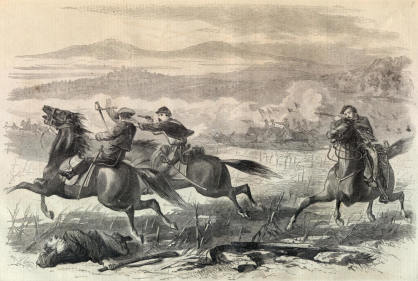
I am a little late on this one- forgive me. Stuff happens. Culpeper historian Clark B. Hall nailed it on the sesquicentennial last week- the anniversary of the last raid by Union forces on our County.
Hall claims Culpeper was the “most fought over” jurisdiction in the course of the war. Some of my friends demur, saying that the residents of Spotsylvania and the Shenandoah Valley have a case, but I will stick with Culpeper pride.
We had the entire Army of Northern Virginia led by Robert E. Lee in town the winter of 1862-63, and the entire Army of the Potomac the next one, on the way to Grant’s Overland Campaign. The little knoll at Brandy Station featured dozens of engagements due to its strategic location at the fords of the Rappahannock River. But whatever.
In 1864, at the start of the Fall, Union forces made their last combat deployment to the County. After that, the fighting moved south toward Richmond and Petersburg, and all that was left for the residents here was the surrender. But the local Confederates did not go quietly, and they fought literally right on the property now occupied by the Russians and Refuge Farm.
In fact, the last general engagement of the war for this County was a resounding victory for the Rebels.
I was thinking about that when I was cutting the backbone out of a while chicken from Croftburn Farms market. I could have asked Andrew the proprietor to cut it out for me, but I suspect that he would have considered me a wimp for that.
A real chef cuts out their own backbones, you know? All it takes is a decent set of shears, or a sharp heavy knife with a wary eye to mind the fingers. A bird with its backbone removed has been “spatchcocked,” as they say Down South, and you can lay it out flat in a pan.
That is also what happened to the Union troops in the last battle in the County, but I will get to that in a minute.
You might ask me why I was removing the backbone from the chicken, and why the Heavy Hands five-pound weight was not by the back door where I pointedly ignore it and on the Corian countertop next to the heavy cast iron skillet that accompanies me everywhere. Well, every kitchen, anyway.
I am channeling Craig Clayborne, legendary food writer in the New York Times and a child of Mississippi. With the weather changing, you know that my attention has turned from outdoor cooking to savory comfort things inside. I decided to try his pressed whole chicken smothered in savory gravy, which involves a cast iron skillet (mine is an antique Erie model), butter, salt and pepper to taste, a plate, a weight, and later on, a roué of flour in the drippings to make delicious gravy and smother that chicken in.
I am thinking fresh peas from the Russian’s garden next door, some wild rice, maybe a baguette if Andrew has them in the middle of the week, and heaven out on the back deck.
From there, I could contemplate what happened in that September long ago.
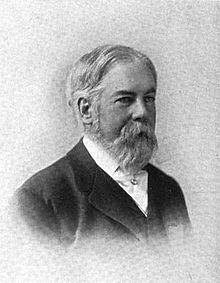
(Col. Henry M. Lazelle, USA. Photo Wikipedia)
Col. Henry M. Lazelle was a Massachusetts-born West Pointer, and he brought 300 troopers of the 13th and 16th New York Cavalry to cross the Rappahannock into Culpeper with the sole objective of spreading mayhem and fear to the County.
Paralleling the Orange and Alexandria railroad tracks, the Yankees (they actually were all Yankees, led by a Yankee) rode through the eastern side of the County to cross the Rapidan at Racoon Ford, a little less than five miles from the farm.
Once across the river, they rousted some Rebel pickets and burned the rail bridge and the depot, and capturing some civilians as hostages (stop me if this sounds familiar). The Yankees then decided to commit some acts of random terror, burning several private residences, some rolling stock from the railroad, the telegraph office and a gristmill.
The raiders then wheeled north, intending to attack the Culpeper Court House on Davis Street, burning the depot at Mitchell’s Station along the way. Locals were hard pressed to respond, and the services of major combat units was required to the south on the lines protecting Petersburg and Richmond.
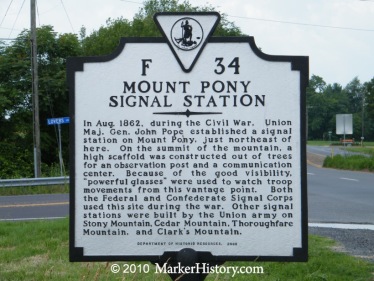
What did surprise Colonel Lazelle’s men was the fact that the requirement for reinforcement cause General Lee to summon a full division of troops from the Shenandoah, and they had arrayed themselves on Mount Pony, overlooking our farms and the Germantown Pike that leads east to Spotsylvania.
The Federals might have been pounding their way up the farm lane in front of our farms, and they were about to be surprised. The Rebels had artillery.
By the time Lazelle knew what he was facing, he was committed. He threw out a line of skirmishers, which drew the infantry down on his force in fury. The New Yorkers fled “in great disorder” with order transformed into a mass of “flying fugitives of both officers and men…” which must have been reminiscent of the flight of the Union Cavalry from J.E.B. Stuart the year before just north of here, near Vint Hill Farm. Stuart called that melee not a battle, but the Buckland Races.
Crossing the Germantown Pike in disarray, the flight continued north of the Rappahannock and back toward the Union main body. Lazelle lost 28 troopers, with 11 more wounded. Confederate casualties were zilch, and almost all the captured civilians managed to make their get away. The Colonel resigned his commission a month later and must have gone into politics, since he returned to military life as “Commandant of Cadets” at West Point as an appointee in 1879.
I don’t imagine he mentioned that his military legacy includes the fact that he had his butt kicked in the last battle fought in Culpeper, 150 years ago last week.
I made a note to talk to Mattski and see if we want to share the cost of a metal detector to look for things the troopers might have dropped in their haste to not have a bayonet stuck in their backsides, and turned my attention back to the chicken.
Andrew only stocks humanely-raised organic chickens, which is probably the best way to source the bird for dinner. I say that now, because there will be a better source even closer soon, when the Russians start raising their own chickens. That is going to make the minor task of removing the backbone pale in comparison with killing the bird and plucking it.
Once you get the backbone out, the bird slumps flat naturally. Take a stick of Irish unsalted butter (It is in the dairy case on the far side of the cooler) and melt it in the skillet. Season the bird to taste with salt and pepper- I normally use adobo rather than salt- but this is southern comfort food, remember.
Here is the trick- when you place the bird skin-side down in the butter at low-moderate heat, place an inverted plate atop it, and then put the weight on top to press it right down. This is the cool part. The Times says you can use a couple cans of tomatoes, if you wish, though I hardly think it matters what is in the can. The Heavy Hands five-pounder works for me.
Hell, bricks would work (though you might want to wrap them in foil.
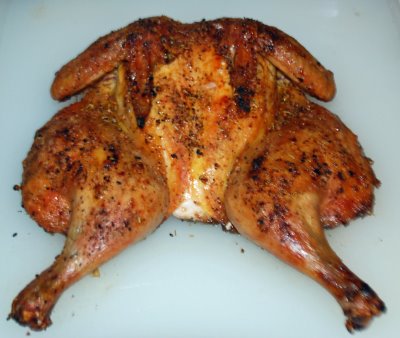
Let it cook about 25 minutes on the one side, remove weight and plate and flip it, then replace the plate and pressure. The skin should be browned nicely on both sides, so another twenty minutes or so. Then remove the chicken and start on the gravy.
Retain a couple tablespoons of the butter and the drippings from the skin in the skillet, sprinkle the flour in to make the roué, whisking madly until it thickens, and then add chicken stock to the desired consistency. I make a lot, since there is nothing better than the gravy on the bird and worked into wild rice with a pat of butter for the string beans.
Return the chicken to the pan with the gravy and allow it to cook yet a little while longer, until tender and nearly coming off the bones. Then remove to a cutting board, hack into pieces and place on a platter. Spoon some of the gravy over the top and serve the rest on the side, with the rice and vegetables.
You could give your smothered chicken a country jolt with mushrooms and pearl onions in the gravy, as Claiborne did, or make it a Cajun fantasy with tomatoes, chopped celery, onion and green peppers added to the sauce.
Oh man. I am so happy I found a use for that damned exercise weight, you know?
Copyright 2014 Vic Socotra
www.vicsocotra.com
Twitter: @jayare303

Fall arrived last night shortly after I retired, exhausted after doing nothing all day. With the breeze in the late afternoon, I decided to wear a light jacket when I went out, and on the voyage of exploration this morning, I found the temperatures settled down into the 40s.
Imagine that- wearing a jacket in the dying moment of summer in Washington, DC! Astonishing thing, and I don’t think it bodes well for a temperate winter. For the moment I am going to make my contingency plans around heading towards the warmth this season, rather than waiting to see if the warmth is going to come to us.
I was puzzling through the wreckage of what passes for world news looking for portents of what is to come. Between the Climate Conference at the UN and the emergence of a hitherto unknown cabal of al Qaida terrorists in Syria significant enough to rain cruise missiles on yesterday, I don’t know what to think.
These are the same cruise missiles that got zeroed in the Navy budget last year. I confess I don’t know what to think. If this new organization- the Khorasan Group- posed an immediate threat to the homeland, it was news to me. The name sounded more like a Washington Defense contractor than an al Qiada offshoot, so go figure. I don’t know whether to be more or less concerned than I was when the end of summer was the issue de jour, but that was yesterday, and the vague feeling of dread remains.
I saw in the morning mess of messages that India, China, Canada and Australia are not going to be attending the big climate summit at the UN today, and had to wonder what that means. There were 310,000 protesters in New York over the weekend, brought by 500 buses. I wondered about that, too. People seem to get bused to a lot of these things, whether it is protests over more money for flipping burgers or whatever, but never mind. China and India produce about a third of all CO2 emissions, so without them I am not sure exactly what the UN is going to do.
But never mind- the scientists are reporting that the Pacific warming is actually part of a century-long cycle of winds, and maybe CO2 isn’t quite the big bogeyman we have been told. If the temperature actually starts to rise again, maybe we should take this seriously. I mean, the temperature is up almost a degree and a half in the last century, so we could be at the tipping point of having a more comfortable winter.
But the whole climate thing seems to be a symptom of something else, something that caught my attention. It is about a way of thinking that I find deeply troubling, which is about the nature of the human experience, and something profound about the species.
You know the Emanuels, right? They are a very talented family. Rahm is the Mayor of Chicago, and not doing that well with it. Probably not his fault, some things are too large to be managed with well-meaning theories. Ari is incredibly successful as a power Hollywood agent. Ezekiel is a medical ethicist, White House insider, and one of the architects of the Affordable Care Act.
They are high-performing brothers with justified confidence in their abilities. Rahm may be the most visible of them, and the most profane in expressing his views, but heck, if you are sure you are right, why not?
Zeke made some news this week himself in the pages of the Atlantic:
http://www.theatlantic.com/features/archive/2014/09/why-i-hope-to-die-at-75/379329/
I had cancelled my subscription to the Atlantic a few months ago after they published a paper advocating the idea of reparations being paid today for the wrongs of a society committed generations ago. I am generally opposed to windfall profits, unless they are coming my way, and wrote them a cordial note to terminate our relationship. It saddened me- I have been a subscriber for most of my life.
Zeke’s article was something I dismissed as a self-indulgent hallucination. He avers that 75 is the age at which he prefers to die. He is 57 this year, though I don’t know his birthday. He does, and thinks that gives him 18 years left on the planet. By his math, he is giving me twelve.
It was a thoughtful article, which I thoroughly enjoyed. I share some of the opinions- not all, of course, but many. Here is the nub of his argument:

(Productivity as opposed to Age. Chart from The Atlantic Monthly.)
According to Zeke, these may be the last words I contribute to Western Civilization. I better hurry.
It did make me think, though. Folks in my family have lived well into their eighties- a few into their nineties, like Grandma. The men seem to lose their grip on mental acuity in their early to mid eighties. Mom kept it together to the end, though she had the same gentle dementia that Grandma demonstrated in her last few years.
Doctor Emanuel makes some astonishing postulations in the article. He cites his own father, a physician and former Zionist guerrilla fighter, who had a heart attack at the age of 77. Despite a degradation in his general performance level, he claims to be still happy and living with Zeke’s Mom in their own house.
I can only deduce that somehow Zeke thinks that is not right.
He even allows as how some people are productive even beyond the age of 75. Would he be suggesting to Mac Showers that the productive use of the almost two full decades he lived beyond 75 is useless? That his independent living was a poor use of the resources he generated through his long life? That he was in complete control of his faculties right to the last decision- his- to go the hospice route?
There is so wrong on so many levels in Zeke’s article that it reminded me of the largest accomplishment in his professional life: the intricate continuing experiment that is the Patient Portability and Affordable Care Act.
The jury is still very much out on whether the thing will ever work, since they haven’t finished even building the web site. But I understand where he is coming from, and recognize anyone would want to find something new and exciting with which to challenge the public imagination.
It actually strikes me as a return to the old and discredited ideas about euthanasia.
In the article, he says he is just going to sit out the preventive procedures that would prolong his life- a passive approach to the last part of life, letting nature take its course. I completely support his personal position, and I am not far from it myself.
But it is also a very fine line between a philosophical opinion about the utility of life and the compulsion to do something about it. I am thinking along the lines of the National Health System in Britain, in which access to care- an admittedly finite resource- and use of a formula by non-medical people to determine the Quality of Life as an outcome. They call it the quality-adjusted life year (QALY) and is used as a tool to assess the value of expending money on medical intervention based on the number of years of life that would be added by the intervention.
Elder patients are routinely denied care, which is essentially what the opponents of the ACA were calling “death panels.”
Call them what you want- if it is a decision by some bureaucrat that you don’t get medical care because of your age, that is precisely what they are. Thank God Mom and Dad were never absorbed into the hospital system and went when the time came- together.
Zeke would tell you he is opposed to assisted suicide and the rest, but his ideas could have some logical consequences that I consider to be fraught with peril.
I don’t know- I think I am keeping a realistic eye on my shelf life, planning for worst case living until I am 85. I could go much sooner, of course, and we just buried one of my most alive friends at 67.
But the thing about the line that Zeke espouses was used by a politician in Berlin to actually do something about getting rid of people he didn’t consider useful to society. It is not far from a suggestion, to a nudge, so something truly monstrous.
I dunno. Maybe I am worked up about nothing but there are certainly some curious ideas floating around these days.
In the meantime, I am interested in the Khorasan Group. They seem to be a more proximate threat than either Zeke’s ideas or Global Warming. I wonder what they thought they were going to do?

(Zeke Emanuel, in 2009, when he had 23 years to go. Photo Wikipedia).
Copyright 2014 Vic Socotra
www.vicsocotra.com
Twitter: @jayare303
Dinner (With Packards)
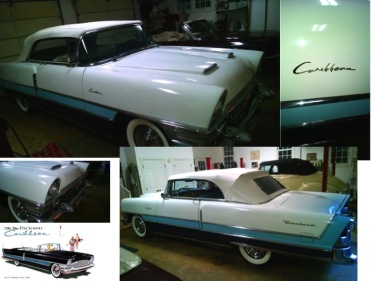
It was the last full day of summer, 2014, and a school night, but the invitation was far too attractive to pass up- dinner with Tom and Claire and a stimulating cast of dinner companions.
I could tell you about the table talk- some of it touched on ancient mysteries and secrets that some people are talking about now, long after the dramatic events. But I will spare you the boredom, or tell you the title of the book and the documentary film if you are interested and you can draw your own conclusions about some amazing events.
In the spirit of the series we were doing during the Car Show period, I have to tell you that Tom is a Packard guy. He waved me out to the garage during the cocktail hour before a most excellent dinner that featured a delightful shrimp salad, composed of diced vegetables from Claire’s garden, slow-cooked chicken, wild rice and fresh peas accompanied by Whole Foods artisan bread and followed by a delightful berry pie a la mode baked by Claire. Tom handled the rest of the culinary chores, but I was most interested in the 1955 Packard Caribbean convertible and the lovely cream-colored 1940 convertible coupe.
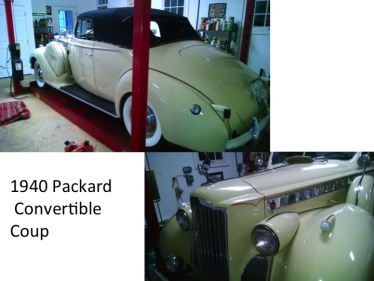
We almost missed dinner, talking about the scheme of George Mason to buy the consolidated Packard-Studebaker concern before his untimely death, and the forthright decision by new AMC Chief George Romney to walk away from the shambling disintegration of the famed Packard brand.
A key item was the folly of Packard’s purchase of the old Chrysler plant adjacent to their main assembly plant in Detroit. The goal was a laudable and visionary- the days of the multi-floor factory were passing and Packard intended to consolidate operations on one single floor, similar to the innovation by the Ford people at Willow Run.
The unintended consequence was that the Chrysler facility was too cramped, and the famed quality of the Packard marque suffered. Tom pointed out the problems in the body fit, and the disappointment in the ultimate driving product of the sleek design.
Purchase price of the Chrysler plant was $25 million, not an inconsequential amount of money in the mid-1950s- and the bottom line to the year for Packard was a net loss of…well, of course. $25 million.
Packard sunk into bankruptcy and receivership, and the factory is now the largest abandoned building and the most infamous example of industrial ruin in the United States. Once employing 40,000 workers and hosting a grocery store and two schools within its complex, the Packard Plant had been abandoned since 1957.

(The sprawling ruin of the Packard assembly plant. Photo Detroit Free Press).
Over in the corner of the garage was an immaculate 1966 Mustang convertible. I think we all have a weakness for the original Pony Car, the one that revolutionized the American auto market. I asked him if it was a new acquisition, and he raised his eyebrows.

“No,” he said with a smile. “I am the original owner. We heard about them when we were getting ready to PCS back from Istanbul where I was the attaché. We picked it up in New Jersey on the way back and have had it ever since. It was our basic transportation for years and years. I got a new coat of paint a few years ago but otherwise, it is stock and just as we bought it.”
“Wow,” I said with a whistle. “How many miles?”
“170,000, I think. It is a good car. We brought both my sons back from the hospital in it.”
“That is a great story,” I said. “I wish I had been able to keep my favorites.”
Tom smiled broadly. “It gets better. It is a tradition now. All the grandkids have been delivered home by Mustang convertable. When we go, I doubt if our sons will fight over the Packards. But I know they will fight about the Ford.”
“I would fight about all of them, Sir.”
“Come on in,: he said, preparing to turn out the garage lights. “I need to get the dinner ready. But I thought you might be interested.”
“We are car people, and you are absolutely right.”
Copyright 2014 Vic Socotra
www.vicsocotra .com
Twitter: @jayare303
Crispy Quinoa Cakes

An alert reader flagged the article in the Washington Post for my attention. He knows I am a part time foodie- his family is as well and are regulars at the farmer’s market around the region. They keep up with trends in American cooking- one of which was picked up in the Post article about Willow.
Willow, as you know, is a “chef driven” restaurant with a distinct forward-leaning attitude. Wheatless by Willow LLC is a stand-alone company founded under the Willow umbrella that produces “delicious, nutritiously sound, and gluten-free artisanal crafted food products.” I am a huge fan, and watching what Tracy is doing from day to day makes me happy I don’t actually work for a living.
I don’t have a dietary need for gluten-free dining- but I recognize what a problem it is for those who are sensitive to the protein composite found in wheat and related grains. As a seasonal whiskey drinker, I note that includes barley and rye. The gluten protein aggravates people with celiac disease, or sensitivities and allergies to wheat. That is a real condition that affects more than a million Americans, though there are millions of other people who believe there are health benefits to a wheatless diet, though that is a speculative view not validated (yet) by science. Of course, the science we hear about these days is mostly wrong, but I can see their point.
Wheat is the oldest cultivated crop known to have been domesticated by humans, and the plant’s ability to self-pollinate greatly facilitated the development of agriculture. The archaeological record suggests that the first wheat crops were grown in the Fertile Crescent around seven thousand years ago. By contrast, anatomically modern humans first appear in the fossil record in Africa about 195,000 years ago, so I would imagine that a digestive system optimized by evolution for a wheat-free world is quite possible.
The cultivation of wheat made possible long-term human habitation in cities, so there is a lot you can blame on wheat.
If you are down at Dupont today, the Wheatless team is serving up Quinoa Goat Cheese Cakes with Feta-Lebneh Sauce & Savory Granola or Eggs-to-Order with Julienned Stachowski’s Ham, Roasted Potatoes, Onions & Mushrooms with Smoked Cheddar Cheese.
Damn, I am getting hungry just typing that.
Bonnie Benwick, Deputy Food and Chief Recipe editor at the Post wrote it up this way: “The next time you’re looking for inventive gluten-free dishes, breads and sweets, check out the offerings at Willow Restaurant and its specialty sub-business, Wheatless by Willow. Chef-owners Tracy O’Grady and Kate Jansen, along with partner Julie Mounts, created these cakes to prove how terrific so-called “starchy” elements can be.”
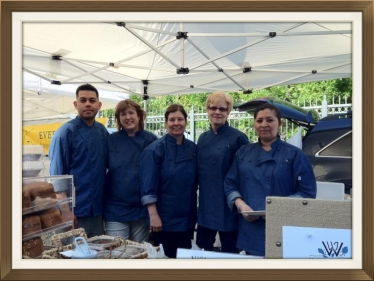
(Julie, Tracy and Kate are flanked by the Wheatless by Willow Staff.)
(I am a huge Kate Jansen fan. She is quiet and reserved, in comparison with outgoing Tracy, who wears her heart on her sleeve. Kate’s baked good, gluten free or with are consistently excellent. The Kummelweck rolls she bakes with sea salt and fennel seeds on top for Buffalo Friday nights at Willow are extraordinary, no other way to describe them. I have special-ordered a dozen to freeze so I can make my own sandwiches when it is not the last Friday of the month, which it is next week. Mark your calendars).
Kummelweck rolls are NOT gluten free, but I am sure Kate and Julie are working on an alternative. Quinoa is a fascinating subject and worth a column of its own. Originally cultivated in mountainous South America, it is grown for its edible seeds. It is a psuedo-cereal closely related to beetroots and spinach, rather than grass. It is high in protein, lacks gluten and is tolerant of dry soil.
Bonnie goes on to say: “When they take the cakes to the FreshFarm Market at Dupont Circle on Sundays, there’s a sellout every time.”
(I talk to Tracy about this all the time- she is very generous with her time and comes out at the start of the evening to shoot the breeze with the regulars. Her weekly trip to the Dupont Circle Farmer’s Market is purely a labor of love to break through in the new and emerging gluten-free market).
“The quinoa cakes can be served a number of ways, as an appetizer as well as a main course. We (The Post) like them with the chef’s simple salad of julienne zucchini and lemon, dressed with olive oil and garnished with a dollop of labneh.”
(That, BTW, is the Post’s hip way to show that they know far more than we do. In point of fact, I was out in the wilds of Vienna the other day and wandered into a place called the Shiraz Wholesale Market. I have to give them five enthusiastic stars.

Dining there was like a trip to the Souk, all under one roof: produce, halal meats (why wouldn’t you eat halal if you had the choice? Or kosher for that matter?)
The bakery and pastry shop are to die for, and the Persian television shows on the big screen are a hoot. Anyway, I got the Kabob special that came with a delicious labneh sauce in small plastic cups, delicate white basmati rice with grated cheese and a side of crisp cucumber salad.
I would write more about that, but this is gluten free.
Oh, yeah: labneh (Persian: لبنة labnah) is yoghurt strained (in a cloth or paper bag, or filter) to remove its whey, resulting in a relatively thick consistency (between that of conventional yogurt and cheese) — while preserving yogurt’s distinctive, sour taste.
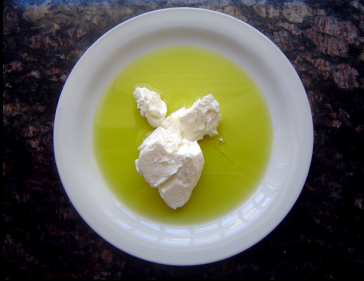
(Labneh can resemble the iconic Playboy bunny symbol, in a way.)
The Shiraz Wholesale Market experience is a gas- the food is inexpensive and delicious and it is absolutely authentic. So much so that you might run into one of the pretenders to the Shah’s Peacock Throne, or the daughter of the former chief of the SAVAK if you are there at the right time. It is at 8486-G Tyco Road, Vienna, Virginia 22182).
Oh yeah, back to the crispy Quinoa cakes: “You’ll need an instant-read thermometer for monitoring the frying oil.”
Make Ahead: The uncooked cakes can be refrigerated for 1 to 2 days.
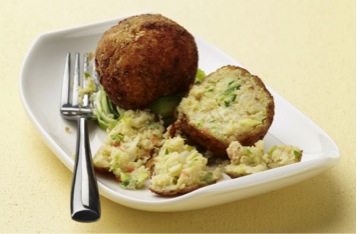
(Quinoa Cakes done by Renee Comet for The Washington Post; image styling by Bonnie S. Benwick.)
The Post’s tested size was 4 servings; this makes 8 cakes. This is Kate’s recipe, provided to the newspaper test kitchen, so I don’t mind passing it along:
INGREDIENTS
• 1 tablespoon extra-virgin olive oil
• 1/4 cup finely diced celery
• 1/4 cup finely diced carrot
• 1/4 cup finely diced onion
• Canola oil, for frying
• 1 cup potato flour, for coating
• 1 1/2 cups cooked quinoa (see NOTE)
• 3/4 cup chopped scallions (green parts)
• 1/2 cup soft goat cheese
• 2 large eggs
• 1/3 cup instant potato flakes, or more as needed
• 1 teaspoon kosher salt
• 1/4 teaspoon freshly cracked black pepper
• Sea salt, for sprinkling (optional)
DIRECTIONS
Heat the olive oil in a large skillet over medium-high heat until the oil shimmers. Add the diced celery, carrot and onion, stirring to coat; cook for about 5 minutes or until tender, then transfer to a large, wide mixing bowl to cool completely.
Pour enough canola oil into a medium nonstick skillet so the oil measures 1 inch deep; heat to 350 degrees over medium-high heat. Line a plate with paper towels. Pour the potato flour into a small, deep bowl.
Add the cooked quinoa, scallions, goat cheese and eggs to the cooled vegetables in the bowl, using your hands to blend the mixture well. Add the potato flakes, then season with the kosher salt and pepper. The mixture should be firm enough to hold together nicely; if it isn’t, add another tablespoon or two of potato flakes. Divide the mixture into 8 equal sections, then use your hands to roll each section into a ball, which will look like an uncooked matzoh ball.
Working with one at a time to preserve their shape, hold a ball in one hand over the potato flour bowl and use your other hand to generously coat it in the potato flour, rotating the ball with your fingers as needed. (This method keeps the balls from being over-floured.) Discard the excess potato flour.
Cook 2 or 3 coated balls at a time in the hot oil — they will flatten ever so slightly into cakes — until golden brown and crisped all over, turning them as needed, about 5 minutes. Use a slotted spatula to transfer them to the paper-towel-lined plate.
Serve warm, sprinkled with a little sea salt, if desired.
NOTE: 1/2 cup of dried quinoa yields about 1 1/2 cups cooked.
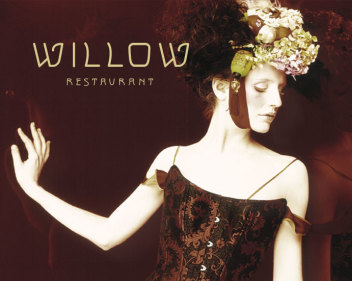
Copyright 2014 Washington Post, Renee Comet and Vic Socotra.
Images Washington Post and Willow Restaurant, Arlington.
www.vicsocotra.com
Twitter: @jayare303
Roll, Caisson
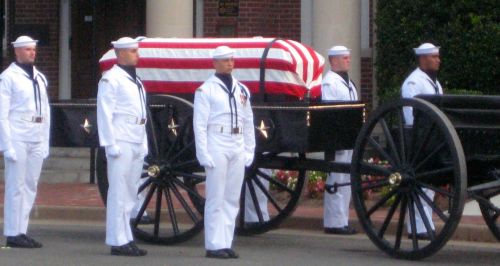
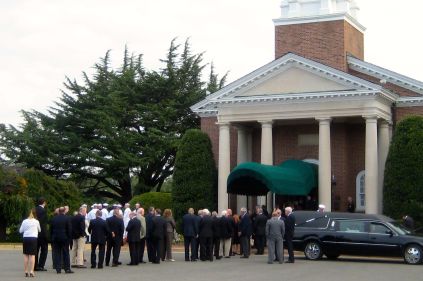
(The line for the SRO crowd to enter the Old Chapel at Fort Myer, adjacent to Arlington National Cemetery. Photos Socotra).
I was holding an early glass of sauvignon blanc on the third-floor balcony of the new Army-Navy Country Club House. The new structure consolidated all the separate functions of several older structures at the central golfcourse, and they did it up right.
The old place had grown in random fashion from the old manor house that stood in the middle of what had been a plantation on the bluff above the Potomac before being bought up by a group of military officers who wanted their own place to play golf and tennis and swim in the summer time. The old patio was on the west side of the building and didn’t have much of a view of the Imperial City that sprawls across the river.
The new clubhouse does, by intent, and a splendid way to watch the foursomes finish up on the ninth hole of the Red Course. I was standing with my old shipmate Rich, talking about life, and friendship and death and eternity.
“I know you knew Scotty from the Bad Guys gold group here at Army-Navy,” I said, waiting an average approach shot onto the 9th green.
“Yeah. We had a good couple decades with the Golf and Green Committee. You were with him in Japan, right?”
I nodded. “Yeah, he was the Maintenance Officer in VF-151 on Midway. Iranian Hostage Crisis days. We were friends ever since.”
It had been standing room only at the Old Post Chapel by the time I got there. Living as close as I do to Arlington National Cemetery, I knew exactly how long it would take to get there, and I allowed plenty of time and was still behind most of the crowd of mourners. I wound up standing at the rear of the chapel, since all the pews were filled.

Scotty’s earthly remains were in the hearse out front, his last motorized ride, since he would be transferring to the caisson pulled by the six horses from the Old Guard, the last equine component of the nation’s Army, and perhaps the most dignified.
It is always weird to face mortality. Scotty was a real presence– he never made a friend he didn’t try to keep, all his life. He was a man’s man, smart, funny and a great connoisseur of the better things in life, perhaps because he had seen many of the worst. I was honored to have been his friend.
The weather was perfect for just about any outdoor activity, including this one.
Scotty’s daughter gave a moving eulogy. She kept it together, despite the emotion that at times seemed to overcome her- and there was a moment of exuberant and irreverent humor from the Lieutenant from the Chaplain Corps, who presided over the service.
“As a fighter pilot, Captain Bates was of the elite of the Navy- like the Chaplain Corps.” The Lieutenant was on his game- much of the crowd was composed of Naval Aviators, an audience that appreciates bravado. There was laugher to go along with the tears that welled up in my eyes when the organist pulled out the stops for Eternal Father, Strong to Save.
That darned song gets me every time- and I didn’t realize my high school had appropriated the melody for our Alma Mater song until a church service at Aviation Officer’s Candidate School, where Holy Services got you away from the Marine Drill instructor for an hour on Sunday Morning.
But like I said, I have been to enough of these funerals to have a direct connection to the simultaneous feeling of loss and affirmation when I hear the hymn to the Almighty to protect “those in peril on the sea.”
The honor guard rolled the casket out, followed by the honorary pallbearers, tall guys of a certain age and the gait of former flyers. Being at the back of the chapel we were the last out. Scotty’s casket was on the caisson and the band was finishing another hymn. The cars were already starting to queue up behind the stretch limo for Debbie and the family, and I realized I might just as well walk behind the limo down to the gravesite. It was a great day for a walk.
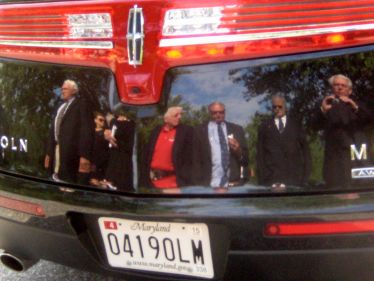
(Mourners rolling the family in the limousine).
Scotty’s widow Debbie and daughter Kimberly showed a lot of class to the SRO crowd of mourners, and I always appreciate the professionalism of the Navy Honor Guard and the soldier of the 3rd Infantry Division- the Old Guard- who manage the horses and caissons. Now I have to figure out where we walked to so I can find Scotty again in my regular rounds to check up on my shipmates.

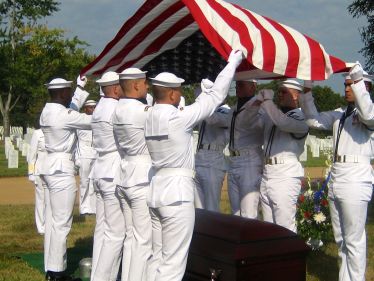
Reception after was at the Army-navy Country Club. I had my regulation two glasses of wine, and was talking to Rich before getting a slice of the steamer round and some baked ham.
Rich and I were shipmates back in the Navy, and later co-workers at Big Blue. We are now attempting to come to grips with the post-employment phase of our lives. He looked out over the foursome finishing up on the ninth hole and mused that the funeral of a good friend- someone who had hurtled at mach speed across the firmament- made one confront one’s own mortality.
“I can’t believe he is gone,” I said. “He would have liked the reception.”
“Scotty liked his whole life. Or at least it is like Kimberly said in her eulogy: the list of things he liked was a lot longer than the list of things he didn’t. I am going to miss him a lot.”
“Carpe diem,” I said, and took a sip of the sauvignon blanc, looking down at the ninth green.

(The view of the 9th Green, nestled in the middle of what was Civil War-era Fort Richardson. Scotty liked this hole to finish on the 27 holes at Arlington.)
Copyright 2014 Vic Socotra
www.vicsocotra.com
Twitter: @jayare303
